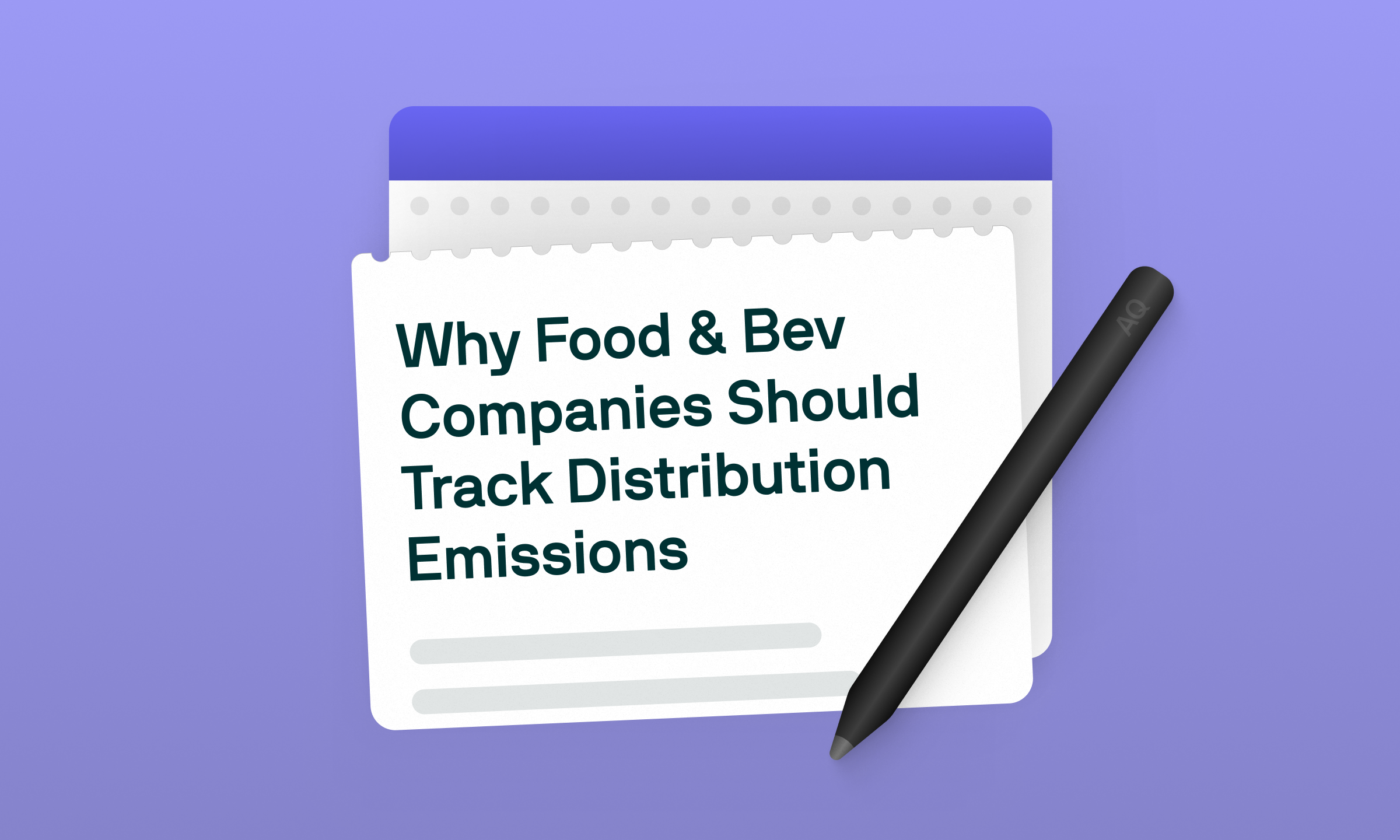Let’s Talk About How Soil Health Can Fix the Climate Crisis

What you'll learn



As we turn the calendar to April, that red circle around the 22nd reminds us of Earth Day and prompts us to think about how our food systems impact the Planet. Because, in the fight against climate change, agriculture can be either the problem or the solution.
Agriculture contributes to 30% of global carbon emissions, consumes 70% of fresh water, drives 60% of biodiversity loss, and causes 80% of tropical deforestation.
In celebration of Earth Day, we've crafted a five-part series to explore the critical intersections between climate change and agriculture. Here’s what we’ll cover:
→ Part 1 \ Climate Change + Soil Health
→ Part 2 \ Climate Change + Water
→ Part 3 \ Climate Change + Coffee & Cacao
→ Part 4 \ Climate Change + Food Waste
Let’s start at the root of the problem, quite literally, soil.
Soil, Not Dirt
Soil is perhaps our most overlooked ally in the fight against climate change.
Half of Earth's species find their home in soil, making it our planet's most biodiverse habitat. In fact, a single teaspoon of healthy soil contains more living organisms than there are humans on Earth.
Globally, soils store approximately three times more carbon than the atmosphere, actively drawing carbon dioxide from the air we breathe. After our oceans, soil represents the planet's largest carbon sink, holding more carbon than all terrestrial plant life combined.

Yet this capacity depends entirely on soil health, and today, 40% of Earth's land is degraded. Soil degradation strips away the physical, chemical, and biological qualities that support life, diminishing soil's ability to store carbon. While degradation occurs naturally, human activities, such as intensive agriculture, deforestation, and urban development, are accelerating this process at an alarming rate.
If soil is such a precious resource we have, why are we treating it like dirt?
The Breaking Point: How Industrial Agriculture Killed Soil
Our agricultural system has reached a critical juncture. In our quest to feed a growing population with greater efficiency, we've sacrificed natural balance for increased yields—and that's precisely where the system broke. Only about 7.5 percent of Earth's surface provides the arable land we rely on for agriculture, and this resource is extremely fragile. Topsoil, the foundation for growing 95 percent of our food, is disappearing ten times faster than it's being replenished.
Modern agriculture damages soil health through monoculture farming, chemical dependence, and dietary pressures that drive unsustainable practices. With global food demand projected to require a 60% increase in crop production by 2050, our business-as-usual mindset is pushing already depleted land to its limits.
But what if the solution already exists beneath our feet? What if healthier soil could simultaneously increase food production while reducing greenhouse gas emissions? The good news is it can.
Reversing the Soil-Climate Loop
The answer to climate change is right beneath our feet. In fact, climate change and soil degradation are locked in a dangerous feedback loop, each accelerating the other:
- Eroded and degraded soil releases its stored carbon into the atmosphere;
- This contributes to global warming;
- Warming conditions intensify rainfall patterns, increase wind speeds, and elevate wildfire risks;
- These extreme weather events further deplete soil health, continuing the cycle.
While this relationship forms a vicious circle, the solution is straightforward. Healthier soil improves agricultural productivity while enhancing carbon sequestration capacity and effectively reversing the cycle from destructive to regenerative.
Now, it’s a matter of understanding and implementing the practices that can boost soil health at scale.
Solutions From the Ground Up
Farm-level Initiatives
At farm level, the solution lies in regenerative organic farming practices: methods that actively build topsoil rather than depleting it. Let's run through some popular initiatives.

Organic Farming
Organic practices eliminate synthetic pesticides, fertilisers, genetically modified organisms, antibiotics, and growth hormones, allowing soil to maintain its natural biological balance.
Compost
By converting farm waste into nutrient-rich compost, farmers create a natural fertiliser and pest deterrent that enhances soil structure while reducing dependency on synthetic inputs.
Cover Crops
Farmers cultivate cover crops alongside their cash crops to increase soil organic matter, actively sequester carbon, and prevent erosion, essentially keeping the soil protected and nourished year-round.
Low-to No-tilling
Conventional tilling—the practice of digging, stirring, and overturning soil—disrupts soil structure and releases stored carbon. Minimising this practice helps soil retain water and organic matter while significantly increasing its carbon storage capacity.
💡 Spotlight: The Perspective of a Seventh-Generation Farmer
Adam Henkel, President at Lee County Farm Bureau, brought generations of agricultural wisdom to our Chicago Food and Beverage Summit. When asked what were "no-brainer initiatives" that farmers could implement, Adam mentioned cover cropping and no-tilling as accessible practices that dramatically improve soil health while enhancing farm productivity.
%20RGB1998-min.jpg)
Mob Grazing
This practice consists of short duration, high density grazing with extended recovery periods for pastures. This practice moves cattle daily across fields, allowing grass to recover for 40-100 days, increasing soil organic matter up to 10 percent (compared to 3.5 percent in conventional fields) and significantly improving water retention and nutrient availability.
Perennial Crops
Agricultural grains are predominantly annual crops requiring yearly replanting. This requires clearing anything that might compete with these crops. By shifting to perennial alternatives that remain in place for years, we reduce soil disturbance, making it easier and more economical to maintain soil health while benefiting the climate.
Diversified Crop Production
Moving beyond monocultures opens possibilities for remarkable diversity in flavours, nutritional profiles, colors, and textures, ultimately creating more resilient agricultural systems that support soil health.
Crop Rotation
This systematic approach of alternating crop varieties from one growing season to the next breaks pest and disease cycles while balancing soil nutrient demands.
Intercropping
Planting multiple crop species in close proximity creates beneficial relationships that can increase overall yields while improving soil structure and fertility over time.
💡 Spotlight: The Three Sisters Method
The agricultural revolution may well come from rediscovering ancient wisdom.
In numerous Indigenous communities, corn, squash, and beans are known as the "Three Sisters." When planted together, these crops create a mutually beneficial relationship that enhances growth and yields.
Corn provides a natural trellis for beans to climb. The beans, in turn, replenish soil nitrogen. Meanwhile, the broad leaves of squash and pumpkin vines serve as living mulch that conserves moisture and suppresses weeds.
Corporate-level Initiatives
If you need the business case for soil health protection, we can talk numbers. With 52% of agricultural land degraded, businesses face $400 billion per year in annual productivity losses. Looking ahead, further deterioration threatens to slash global food output by 12% whilst driving a 30% rise in food prices over the next 25 years. This makes it essential for Food & Beverage companies to collaborate directly with farmers to support and drive meaningful change.
💡 Spotlight: Using Underpants to Signal Soil Health
At our events, we've heard Nestlé leadership tell the story of how they've obtained corporate buy-in using the 'Underpants Project'. Originally a Swiss citizen science initiative, this ingenious approach involves burying cotton underwear in different soil types to measure biological activity. Healthier soils rapidly decompose the cotton, leaving behind only the elastic waistband, creating a striking visual demonstration that turns soil health from an abstract concept into visible effects.
Policy-level Initiatives
While grassroots action is essential, effective policies are equally crucial for supporting regenerative agriculture. Governments can drive large-scale adoption of sustainable soil management by:
- Providing farmers with information and technical support, like India's Soil Health Card Scheme that offers crop-specific fertiliser recommendations based on soil testing.
- Creating financial incentives that reward soil protection, as seen in the Netherlands where the government is working on a carbon scheme to compensate farmers for reducing soil carbon loss.
- Establishing clear regulatory standards, such as the EU's Common Agricultural Policy requirements for maintaining minimum soil cover and sustainable land management.
- Developing accessible soil monitoring systems, as the Land Degradation Surveillance Network which creates digital soil maps using remote sensing, and field sampling data.
💡 Spotlight: The Grain for Green Project
China's Loess Plateau restoration project demonstrates how policy initiatives can reverse severe soil degradation. Once considered the most eroded place on Earth, this 245,000-square-mile region was transformed through the "Grain for Green" programme.
The Chinese government implemented a comprehensive subsidy system, including:
- Grain and cash payments to farmers converting cropland to forests or grasslands
- Tax benefits to offset farming losses
- Long-term land use contracts
- Tree-planting employment programmes
While initial community resistance centred on food security concerns, the programme ultimately improved rather than compromised fertility, with grain yields eventually increasing after an initial drop.
This holistic approach resulted in a 25% increase in vegetative cover within a decade and significant reductions in erosion, demonstrating how coordinated policy actions with appropriate economic incentives can successfully rehabilitate degraded soils at scale while maintaining agricultural productivity.
Certifications: Adding Value Through Verification
These three key certifications can help secure premium pricing for your healthy soil investments:
LEAF (Linking Environment And Farming)
A UK-based certification focusing on Integrated Farm Management that requires evidence of sustainable soil practices. LEAF emphasises crop rotation, reduced tillage, and careful fertiliser application, whilst requiring ongoing soil monitoring. It's gaining significant traction with UK retailers who are increasingly willing to pay for these verified standards.
Red Tractor
The UK's largest farm assurance scheme, requiring farmers to maintain soil structure and fertility through documented management plans. While less soil-focused than other certifications, its widespread consumer recognition makes it a practical starting point for British producers looking to demonstrate basic soil stewardship.
Regenerative Organic Certified (ROC)
Building upon organic standards, this certification addresses soil health alongside animal welfare and social fairness. ROC requires practices like cover cropping and reduced tillage while prohibiting GMOs and synthetic inputs. It’s based on a tiered approach (Bronze to Gold) and offers valuable verification in US markets.
Additional Resources
In case you want to dig deeper, here’s some of our team’s favourites on soil health and regenerative agriculture:
📓 Rooted: Stories of Life, Land and a Farming Revolution, by Sarah Langford
📓 Dirt to Soil: One Family’s Journey into Regenerative Agriculture, by Gabe Brown
📺 Six Inches of Soil, by Colin Ramsay
📺 Living Soil, by Chelsea Myers


.svg.webp)






.png)



